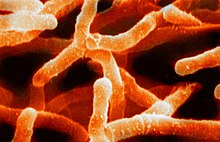 Global Information
Global InformationActinomycetota information
| Actinomycetota | |
|---|---|

| |
| Scanning electron micrograph of Actinomyces israelii. | |
| Scientific classification | |
| Domain: | Bacteria |
| Clade: | Terrabacteria |
| Phylum: | Actinomycetota Goodfellow 2021[1] |
| Type genus | |
| Actinomyces Harz 1877 (Approved Lists 1980)
| |
| Classes[2] | |
| |
| Synonyms | |
| |
The Actinomycetota (or Actinobacteria) are a diverse phylum of Gram-positive bacteria with high G+C content.[4] They can be terrestrial or aquatic.[5] They are of great economic importance to humans because agriculture and forests depend on their contributions to soil systems. In soil they help to decompose the organic matter of dead organisms so the molecules can be taken up anew by plants. While this role is also played by fungi, Actinomycetota are much smaller and likely do not occupy the same ecological niche. In this role the colonies often grow extensive mycelia, like a fungus would, and the name of an important order of the phylum, Actinomycetales (the actinomycetes), reflects that they were long believed to be fungi. Some soil actinomycetota (such as Frankia) live symbiotically with the plants whose roots pervade the soil, fixing nitrogen for the plants in exchange for access to some of the plant's saccharides. Other species, such as many members of the genus Mycobacterium, are important pathogens.
Beyond the great interest in Actinomycetota for their soil role, much is yet to be learned about them. Although currently understood primarily as soil bacteria, they might be more abundant in fresh waters.[6] Actinomycetota is one of the dominant bacterial phyla and contains one of the largest of bacterial genera, Streptomyces.[7] Streptomyces and other actinomycetota are major contributors to biological buffering of soils.[8] They are also the source of many antibiotics.[9][10]
The Actinomycetota genus Bifidobacterium is the most common bacteria in the microbiome of human infants.[11] Although adults have fewer bifidobacteria, intestinal bifidobacteria help maintain the mucosal barrier and reduce lipopolysaccharide in the intestine.[12]
Although some of the largest and most complex bacterial cells belong to the Actinomycetota, the group of marine Actinomarinales has been described as possessing the smallest free-living prokaryotic cells.[13]
Some Siberian or Antarctic Actinomycetota is said to be the oldest living organism on Earth, frozen in permafrost at around half a million years ago.[14][15] The symptoms of life were detected by CO2 release from permafrost samples 640 kya or younger.[16]
- ^ Oren A, Garrity GM (2021). "Valid publication of the names of forty-two phyla of prokaryotes". Int J Syst Evol Microbiol. 71 (10): 5056. doi:10.1099/ijsem.0.005056. PMID 34694987. S2CID 239887308.
- ^ Euzéby JP, Parte AC. "Actinobacteria". List of Prokaryotic names with Standing in Nomenclature (LPSN). Archived from the original on May 6, 2021. Retrieved June 7, 2021.
- ^ Goodfellow M (2012). "Phylum XXVI. Actinobacteria phyl. nov.". In Goodfellow M, Kämpfer P, Trujillo ME, Suzuki K, Ludwig W, Whitman WB (eds.). Bergey's Manual of Systematic Bacteriology. Vol. 5 (2nd ed.). New York, NY: Springer. pp. 33–34.
- ^ Gao B, Gupta RS (March 2012). "Phylogenetic framework and molecular signatures for the main clades of the phylum Actinobacteria". Microbiology and Molecular Biology Reviews. 76 (1): 66–112. doi:10.1128/MMBR.05011-11. PMC 3294427. PMID 22390973.
- ^ Servin JA, Herbold CW, Skophammer RG, Lake JA (January 2008). "Evidence excluding the root of the tree of life from the actinobacteria". Mol. Biol. Evol. 25 (1): 1–4. doi:10.1093/molbev/msm249. PMID 18003601.
- ^ Ghai R, Rodriguez-Valera F, McMahon KD, Toyama D, Rinke R, Cristina Souza de Oliveira T, et al. (2011). Lopez-Garcia P (ed.). "Metagenomics of the water column in the pristine upper course of the Amazon river". PLOS ONE. 6 (8): e23785. Bibcode:2011PLoSO...623785G. doi:10.1371/journal.pone.0023785. PMC 3158796. PMID 21915244.
- ^ Hogan CM (2010). "Bacteria". In Draggan S, Cleveland CJ (eds.). Encyclopedia of Earth. Washington DC: National Council for Science and the Environment. Archived from the original on 2011-05-11.
- ^ Ningthoujam DS, Sanasam S, Tamreihao K, Nimaichand S (November 2009). "Antagonistic activities of local actinomycete isolates against rice fungal pathogens". African Journal of Microbiology Research. 3 (11): 737–742.
- ^ Donald, Lavinia; Pipite, Atanas; Subramani, Ramesh; Owen, Jeremy; Keyzers, Robert A.; Taufa, Taitusi (2022). "Streptomyces: Still the Biggest Producer of New Natural Secondary Metabolites, a Current Perspective". Microbiology Research. 13 (3): 418–465. doi:10.3390/microbiolres13030031. ISSN 2036-7481.
- ^ Procópio, Rudi Emerson de Lima; Silva, Ingrid Reis da; Martins, Mayra Kassawara; Azevedo, João Lúcio de; Araújo, Janete Magali de (2012). "Antibiotics produced by Streptomyces". The Brazilian Journal of Infectious Diseases. 16 (5): 466–471. doi:10.1016/j.bjid.2012.08.014. ISSN 1678-4391. PMID 22975171.
- ^ Turroni F, Peano C, Pass DA, Foroni E, Severgnini M, Claesson MJ, Kerr C, Hourihane J, Murray D, Fuligni F, Gueimonde M, Margolles A, De Bellis G, O'Toole PW, van Sinderen D, Marchesi JR, Ventura M (2012-05-11). "Diversity of bifidobacteria within the infant gut microbiota". PLOS ONE. 7 (5): e36957. Bibcode:2012PLoSO...736957T. doi:10.1371/journal.pone.0036957. PMC 3350489. PMID 22606315.
- ^ Pinzone MR, Celesia BM, Di Rosa M, Cacopardo B, Nunnari G (2012). "Microbial translocation in chronic liver diseases". International Journal of Microbiology. 2012: 694629. doi:10.1155/2012/694629. PMC 3405644. PMID 22848224.
- ^ Ghai R, Mizuno CM, Picazo A, Camacho A, Rodriguez-Valera F (2013). "Metagenomics uncovers a new group of low GC and ultra-small marine Actinobacteria". Scientific Reports. 3: 2471. Bibcode:2013NatSR...3E2471G. doi:10.1038/srep02471. PMC 3747508. PMID 23959135.
- ^ Sample I (2 May 2010). "The oldest living organisms: ancient survivors with a fragile future". The Guardian. Archived from the original on 2013-03-02.
- ^ Hanson J. "The oldest living thing in the world". It's Okay to be Smart. Archived from the original on 2018-07-13. Retrieved 2018-07-13.
- ^ Johnson SS, Hebsgaard MB, Christensen TR, Mastepanov M, Nielsen R, Munch K, et al. (September 2007). "Ancient bacteria show evidence of DNA repair". Proceedings of the National Academy of Sciences of the United States of America. 104 (36): 14401–14405. Bibcode:2007PNAS..10414401J. doi:10.1073/pnas.0706787104. PMC 1958816. PMID 17728401.